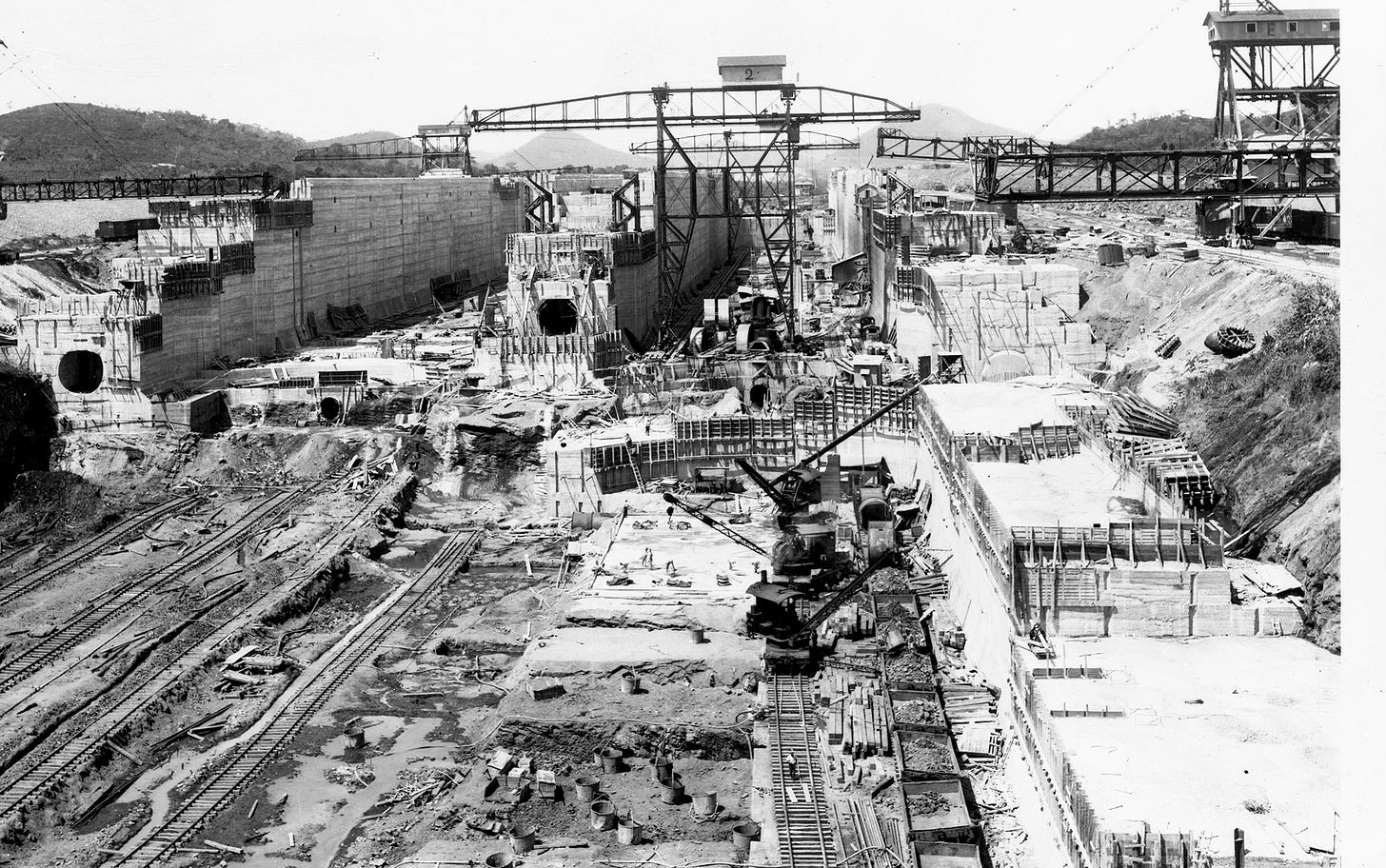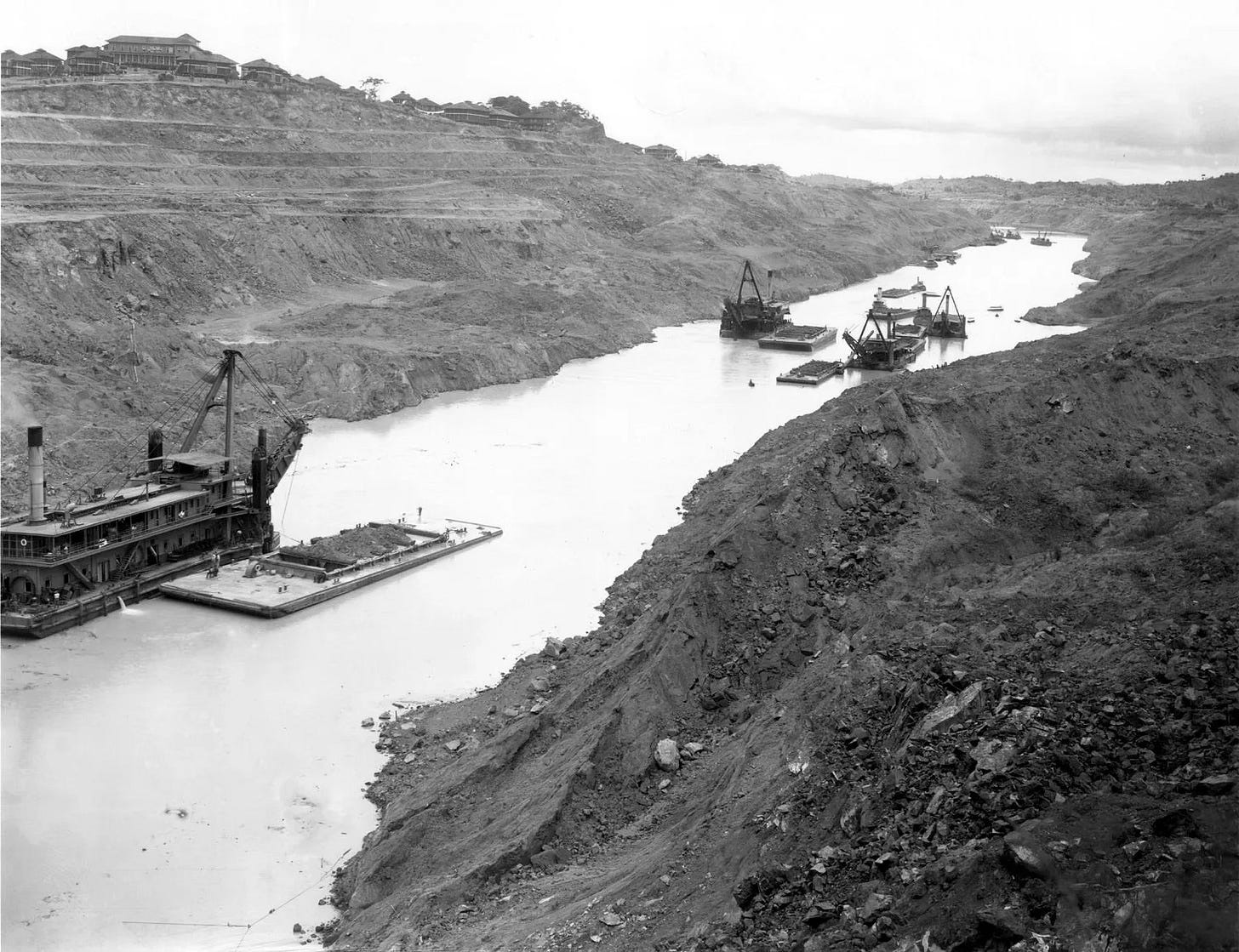The Panama Canal has been in the news in recent days. Here’s a look-back to when it was built and eventually handed-over.
The Panama Canal was fraught with construction challenges. Its construction was the site of the deaths of tens of thousands of workers. The canal led to the discovery that yellow fever and malaria were mosquito-borne diseases. It witnessed American gun-boat diplomacy. And it was the subject of a major presidential flip-flop.
The Panama Canal is one of the greatest engineering marvels of all time. The canal runs about fifty miles through Panama, connecting the Atlantic and Pacific Oceans. The 15- to 25-hour journey to transit from one ocean to another was a dramatic improvement over the previous route. Prior to the construction of the Panama Canal, ships sailing from the United States’ mid-Atlantic coast to the California coast would need to sail an additional eight thousand miles around Cape Horn, the southernmost point of the South American mainland. The American Society of Civil Engineers named the Panama Canal one of the seven man-made wonders of the world.
The French were the first to seriously attempt to carve a canal through the Panama isthmus. In the 1880s, a French firm, employing thousands of workers in the region, began construction. After nearly a decade, the expenditure of about $250 million, and the deaths of more than twenty thousand workers, the firm went bankrupt.
A second French effort yielded little. This led to the US purchase of the French property and construction rights for $40 million in 1902.[1] A treaty was negotiated between the United States and Colombia because Panama was part of the South American nation at the time. The Colombian legislature did not ratify the treaty, but new developments gave the United States hope that a deal could be reached. Panamanians were considering breaking away from Colombia. The United States signaled it would support the independence of Panama.
When Panama declared independence on November 3, 1903, the United States stationed the gunboat USS Nashville (PG-7) off the coast to guard against Colombian troops attempting to retake control of the newly independent nation. The Nashville’s presence epitomized gunboat diplomacy.[2]
The Provisional Government Junta of the Republic of Panama, the name of the newly independent nation’s government, appointed Philippe Bunau-Varilla as Envoy Extraordinary and Minister Plenipotentiary to the United States on November 6. Bunau-Varilla was the chief engineer of the French project. After France abandoned it, he actively lobbied the United States to purchase canal rights from the French.[3]
On November 18, 1903, the Hay-Bunau-Varilla Treaty was executed, giving rights and control of what would become the Panama Canal to the United States in perpetuity in return for $10 million and annual payments. The United States also guaranteed the independence of Panama.[4] Both the US Senate and the new Panamanian government ratified the treaty.
The United States took control of French equipment and buildings that were in a serious state of disrepair after 15 years of disuse. The United States began renovating whatever equipment and buildings it could, replaced others, and formulated a plan of action to build the canal.
Similar to the French approach, senior management and highly skilled positions were filled by Americans, while unskilled positions were filled by immigrants. Some immigrants were Western Europeans and others were from nations around the Caribbean Basin.
Just as critical to the success of the project were developments in sanitation, worker health, and living conditions. Chief among these was the implementation of precautionary measures arising from the discovery that yellow fever and malaria were mosquito-borne diseases.[5]
Most of the more than twenty thousand French worker deaths were attributed to these two diseases and a few others, such as cholera. In fact, so many Europeans had fallen ill and died that Panama became known as “the white man’s graveyard.”[6]
The most difficult aspect of the construction was carving through the Continental Divide mountain range that ran through Panama. The project cut through the lowest point of the range, but still had to reduce the mountains from about three hundred feet above sea level to about forty feet. This had to be accomplished for a distance of about eight miles.
Canal construction included a pair of man-made lakes and six sets of locks that were used to raise and lower water levels as ships transited from one ocean to the other.[7] In mid-transit, a ship would be 85 feet above sea level to account for the differences in elevation of the middle of Panama as compared to the Atlantic and Pacific coastlines.[8]
After assuming control of the canal in 1904, the project took the United States about a decade to complete. It was opened and began operation in August 1914. Construction began midway through Theodore Roosevelt’s presidency, encompassed the entire presidency of one-term William Howard Taft, and ended with the canal’s opening during the first term of Woodrow Wilson.
For nearly seven decades, the ten-mile-wide and fifty-mile-long Panama Canal Zone was the territory of the United States. It was an American owned and operated canal. Despite the 1904 treaty, this arrangement proved to be contentious, with many Panamanians objecting to what they viewed as a loss of sovereignty. Over the years, there were a few violent clashes between Panamanians and the US military forces providing security for the Canal Zone.
In response to accusations of imperialism and colonialism by satellite nations in the Soviet Union’s orbit, the presidential administration of Richard Nixon began discussions in 1970 to change the arrangements between the United States and Panama.[9] In 1973, longtime diplomat Ellsworth Bunker was appointed to lead the US negotiations. Over the next several years, Bunker slowly drafted agreements that would shift control and ownership of the Panama Canal from the United States to Panama.
During the 1976 presidential race, President Gerald Ford advocated for a treaty to transfer canal control to Panama. His general election opponent did not. Jimmy Carter pledged the United States would continue its control of the Panama Canal.[10] During the October 6 debate on foreign policy issues held at San Francisco’s Palace of Fine Arts, Carter said he would not give up “practical control of the Panama Canal Zone any time in the foreseeable future.”
After the election, and before he was inaugurated as the 39th president, Carter reversed himself on turning over control of the canal to Panama. In a January 3, 1977, interview with Time magazine, Carter was asked, “What do you hope to get done first?” Carter replied, “I think the Panama treaty ought to be resolved quite rapidly.”[11] This was perhaps the greatest presidential flip-flop of all time.
The years of groundwork laid by Ellsworth Bunker helped US negotiators to finalize an agreement in principle. In order to increase the chances of Senate ratification, Carter and Panama leader General Omar Torrijos signed two treaties in September 1977. The Treaty Concerning the Permanent Neutrality and Operation of the Panama Canal guaranteed the United States the right to intervene militarily if the neutrality of the Panama Canal Zone was at stake. The second treaty, The Panama Canal Treaty, called for the end of the US-controlled Panama Canal Zone in October 1979 and transition control to Panama over the next twenty years. Panama would take complete control of the Panama Canal on January 1, 2000.
The Senate narrowly ratified the two treaties by April 1978, each with a one-vote margin.
Mark Hyman is a 35-year military veteran and an Emmy award-winning investigative journalist. Follow him on Twitter, Gettr, and Parler at @markhyman, and on Truth Social at @markhyman81.
Mark welcomes all news tips and story ideas in the strictest of confidence. You can reach him at markhyman.tv (at) gmail.com.
[1] Donald Barr Chidsey, The Panama Canal: An Informal History, (New York: Crown, 1970), 103.
[2] Chidsey, The Panama Canal, 117.
[3] Philippe Bunau-Varilla, From Panama to Verdun: My Fight for France, (Philadelphia: Dorrance, 1940), 150.
[4] Paul J. Scheips, The Panama Canal: Readings on its History, (Delaware: Michael Glazier, 1979), 125.
[5] Sylvia Engdahl, Perspectives on Modern World History: Building the Panama Canal, (Detroit: Greenhaven Press, 2012), 25-27.
[6] David McCullough, The Path Between the Seas: The Creation of the Panama Canal 1870-1914, (New York: Simon and Schuster, 1977), 140
[7] Thomas J. Cutler, The US Naval Institute on the Panama Canal, (Annapolis: Naval Institute Press, 2016), 24.
[8] Engdahl, Perspectives on Modern World History, 39.
[9] Jimmy Carter, Keeping Faith: Memoirs of a President, (Toronto: Bantam, 1982), 154.
[10] James Wooten, Untitled, New York Times, June 24, 1976.
[11] Don Richardson, Conversations with Carter, (Boulder: Lynne Rienner Publishers, 1998), 68.





You might considering mentioning that not a single Panamanian was present at the signing of Hay-Bunau-Varilla Treaty.